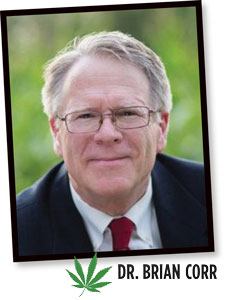3/1/2019
It’s a Puzzlement
Dr. Brian Corr

Researchers at Purdue University recently published a paper* entitled “Cannabis as a Conundrum” discussing the complexities of choosing pesticides for use in cannabis production while the federal government has strict regulations about production of the plant.
The article got me thinking of all the conundrums, contradictions and inconsistencies related to cannabis. If I could be as eloquent as Sir Winston Churchill, I might say there are riddles wrapped in mysteries inside enigmas. Or as Yul Brynner, in “The King and I” might say, “It’s a puzzlement.”
In the United States, many puzzlements result because cannabis is simultaneously a federally controlled substance, a profitable specialty crop in certain states and a potentially important field crop. Federal regulations limit the ability of university researchers and large companies to conduct solid research or the usual product development processes. As a result, decisions are being made, big and small, with little data to inform those decisions.
The most critical decisions are about human health. Cannabis is being recommended for everything from recreational use to treating cancer. Research is needed regarding the potential health effects of cannabis, both positive and negative. Research is increasing now in the United States, but even more so in countries like Canada and Israel.
Important questions, such as the relative importance of the 100-plus different cannabinoids and 100-plus terpenes in cannabis, are yet to be answered. Research will go a long way to answering why some cultivars of cannabis, but not others, seem to have benefits for some people. Potential negative health consequences need to be researched also. Like most things, cannabis isn’t completely benign.
Research to support production decisions is also needed. How much phosphorus does cannabis need for a successful crop? What’s the critical daylength for each cultivar? For other crops, these cultural questions are answered by university research or by industry suppliers. In cannabis, reports of what’s worked may or may not be accurate. The scientific method is often lacking.
Perhaps the biggest puzzlement is the inconsistent attitude of the United States government. Until the recent passage of the 2018 Farm Bill, cannabis with significant quantities of cannabinoids was a controlled substance, a schedule 1 drug (defined as having no accepted medical use and a high potential for abuse). However, the U.S. Department of Health and Human Services applied for and in 2003 received United States Patent 6,630,507 for the medical use of “cannabinoids useful in the treatment and prophylaxis of wide variety of oxidation associated diseases.”
The Farm Bill allows for production of hemp, which is defined as cannabis with less than 0.3% THC. The very last page of the bill amends the controlled substances act so “the term ‘marihuana’ does not include hemp.” This, along with the rest of the bill opens up interstate commerce in non-THC cannabis. Also in 2018, the U.S. Drug Enforcement Agency rescheduled “finished dosage formulations” of the non-psychoactive cannabinoid cannabidiol (CBD) from schedule 1 to schedule 5, as long as the THC content is less than 0.1% (a different value than the Farm Bill). A schedule 5 drug is recognized as having a low potential for abuse and has medical value.
Since consumers have significant interest in CBD, the Farm Bill and the rescheduling of CBD seem to align to allow production of CBD products. But not so fast! In mid-2018, the U.S. Food and Drug Administration (FDA) approved the prescription drug Epidiolex containing CBD for treatment of some seizures. Then, on the very same day the Farm Bill was signed, the FDA issued a press release making clear the FDA will not allow sales of products containing CBD because CBD is a pharmaceutical ingredient (in Epidiolex).
So, at the beginning of 2018, CBD-only cannabis products couldn’t be sold because they had no medical value. At the end of 2018, CBD-only cannabis products couldn’t be sold because there’s a product containing CBD with medical value.
It’s a puzzlement.
The FDA has determined hemp seeds, hemp seed protein and hemp seed oil are Generally Recognized as Safe (GRAS) and can be sold. And the FDA will open up discussions about how to make CBD sales possible, so there is hope the CBD puzzlement will be resolved.
Another puzzlement is how governments consider taxes related to cannabis. States in the U.S. welcome the tax revenue that state-legal cannabis brings in. For example, in 2018, Colorado collected about a billion dollars in taxes, fees and licenses from cannabis businesses. However, the U.S. federal tax code section 280 E limits what tax deductions those cannabis businesses can take.
The U.S. Internal Revenue Service has decided that “no deduction or credit shall be allowed for any amount paid or incurred during the taxable year in carrying on any trade or business if such trade or business … consists of trafficking in controlled substances ...” In other words, many business deductions allowable in other businesses are not allowed in cannabis businesses, but there’s no hesitation taxing cannabis businesses.
Once again, perhaps the King of Siam said it best:
There are times I almost think
I am not sure of what I absolutely know
Very often find confusion
In conclusion, I concluded long ago
Indeed, much of what goes on regarding cannabis is a puzzlement. GT
Dr. Brian Corr is a consultant with more than four decades of experience in the greenhouse industry. He has advised legal cannabis producers for the last three years. You can reach him at Brian.Corr@SycamoreHortConsulting.com.
*Sandler, L. N., Beckerman, J. L., Whitford, F., & Gibson, K. A. (2019). Cannabis as conundrum. Crop Protection, 117, 37-44.